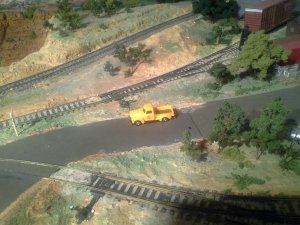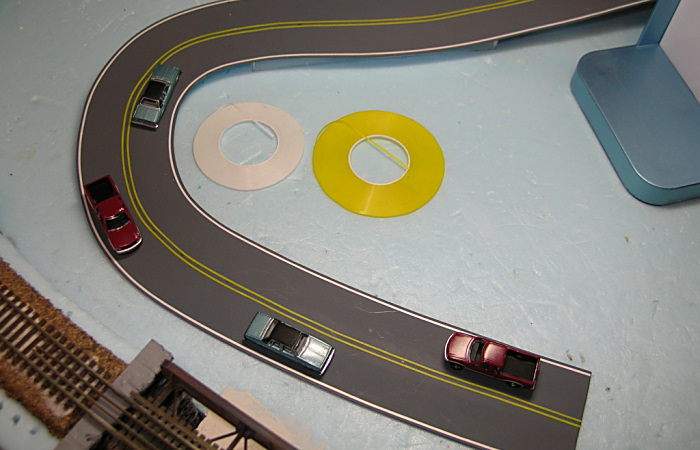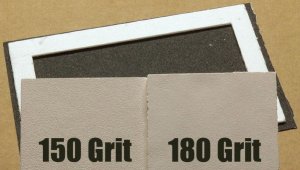I've been working on a mockup of some street trackage using the craft foam.
I used 1mm black craft foam on code 100 track. You can go the full width of the rails and not interfere with the flanges as long as they aren't pizza cutters. The stuff at Michael's is 2mm (Hobby Lobby's is even thicker), which is fine for roads without track, but for street trackage you'll need to order some 1mm. An eBay seller named Wandy-Foam sells it.
The white foam underneath is
Readiboard from the Dollar Tree store. While you're there, get some
LA's Awesome spray cleaner. Spray it all over the board, wait a minute, and then peel off the paper layers. Do both sides or it may warp. You'll be left with a foam sheet that's a few millimeters thick. I sanded the white foam to give the road a crown. I also sanded in some dips and ruts, though they don't show up very well in the photos. They need to be exaggerated.
The paint is water-based craft paint from Michael's or Walmart. You can buy shades of gray paint, but if you want to mix your own, mixing black with white will result in a blueish tint. I mixed black with a light tan (suede) to remove any tint. I dabbed it on using a damp kitchen sponge. Look for a sponge that doesn't have any sort of pattern embossed into it. I also cut the sponge in half, using one half to apply the paint. The other was kept clean and damp and was used to remove paint if needed, such as the dark areas down the middle of the lanes. You want to dab the sponge on something else first, such as a piece of cardboard, to remove some paint (sort of like dry brushing.)

After the paint is dry, you can create patches and large cracks by tearing the craft foam. If you want fairly straight lines, score the underside of the foam with an X-Acto before tearing it. If you want more irregular lines then don't bother scoring first. To darken the patches I just ran them under the faucet for a minute and rubbed them with my finger to remove paint. Some patches are lighter than the road, so mix up a batch of light gray and dab some onto the patch.
For the small cracks I took a straight pin, clipped off the head, and chucked it into my Dremel mototool. I also used the grinding wheel on my Dremel to file a flat spot on the side of the pin point to give it a bit of a cutting edge. Then just etch the cracks into the craft foam. You can control the width of the cracks by how deep the pin penetrates. It helps to have some reference photos when drawing cracks. The street view on Google maps is good for this. You can paint tar lines on some of the cracks with a long thin brush. Use very dark gray instead of black because even tar fades.
For the white lines, I didn't want to use decals or chart tape because those would be too perfect for an old worn road. I used masking tape to mask off the lines. I reduced the stickiness of the tape by pressing it to the floor and pulling it up a few times. Even after doing this it took up a little bit of paint which really didn't look that bad. It gave some random wear to the pavement. If you don't want the tape to pull up any paint you should probably seal the foam with clear flat spray paint first.
I used the sponge to dab the white paint for the lines. The water in the sponge apparently allowed the paint to bleed a little under the tape making the edges a little messy in spots. I probably should have used a cosmetics sponge for this. Those don't need to be moist to be kept soft.
I brushed some real dirt onto road to make it look better.
I attached the craft foam to the white foam using spray adhesive.
ETA: I should give credit where credit is due. I originally tried a technique described by
Dan Crowley where he brushed tinted plaster on top of craft foam. The rigid plaster wasn't suitable for between the rails, and it didn't really allow for cutting out patches, but it got me to experiment with the craft foam.
Steve S




